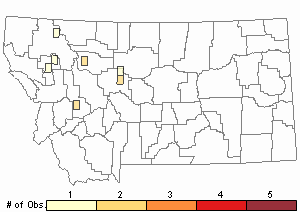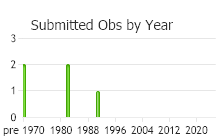View in other NatureServe Network Field Guides
NatureServe
Montana
Utah
Wyoming
Idaho
Wisconsin
British Columbia
South Carolina
Yukon
California
New York
A Conardia Moss - Conardia compacta
General Description
Plants: Pleurocarpous. Growing in open to crowded mats. Stems prostrate or curving upward, branching somewhat in one plane; pseudoparaphyllia leaf-like or of filaments; rhizoids or their initials commonly on the stem, also on the dorsal side of the costa, and on the lamina close to the leaf tip, branching profusely, papillose; possessing a central strand and without a hyalodermis; axillary hairs with 1-4 transparent upper cells (FNA 2014). Branches short and upwardly inclined (Crum & Anderson et al. 1981).
Leaves: Stem leaves dense, upright to spreading, sometimes a little curved, tending to point in one direction when dry, 0.6-1.2 mm in length, lance-shaped, sometimes with ovate tendencies, steadily tapering to the leaf tip, a little cupped, with a flat or longitudinally grooved acumen; margins finely toothed with larger teeth proximally, flat to curved inward or outward, unbordered; base extending down the stem; costa extending into the acumen, sometimes nearly reaching the apex (FNA 2014).
Leaf Cells: Alar cells mostly quadrangular, not swollen, typically numerous, the region wide, extending from the leaf edge to or almost to the nerve at the attachment, the boundary imprecise; laminal cells long and narrow; basal cells wider and not as long as the laminal cells; margins 1 cell-layer thick (FNA 2014).
Diagnostic Characteristics
The profusely branching and papillose rhizoids arising from the dorsal costal surface and from the lamina near the leaf tip distinguish Conardia from small Amblystegium species (FNA 2014; Malcolm & Malcolm 2009).
Range Comments
North American Range
AK to NL and NS, and in most states of the continental US except in the southeast and those northeast of NY; Mexico (FNA 2014). Known in Montana from Cascade, Flathead, Lake, Lewis and Clark, Lincoln, Powell, and Teton Counties (Elliott 2016).
Observations in Montana Natural Heritage Program Database
Number of Observations: 12
(Click on the following maps and charts to see full sized version)
Map Help and Descriptions
Relative Density

Recency


 (Observations spanning multiple months or years are excluded from time charts)
(Observations spanning multiple months or years are excluded from time charts)
Habitat
Wet rock and wood, often in calcareous fens (Elliott 2016), damp bluffs, humus (FNA 2014).
Reproductive Characteristics
Autoicous. Perichaetial leaves not pleated longitudinally, the margins erratically and finely toothed in the upper part. Seta yellow with orange tones, more red near the bottom, 8-14 mm tall. Capsule bowed, inclined (FNA 2014); operculum with apiculus askew (Crum & Anderson et al. 1981); exostome divisions with a network of lines at the base (FNA 2014); cilia short or none (Crum & Anderson et al. 1981).
Specialized vegetative reproduction by gemmae arising on the dorsal costal surface, the gemmae papillose and producing rhizoids (FNA 2014).
Stewardship Responsibility
References
- Literature Cited AboveLegend:
 View Online Publication
View Online Publication Crum, H.A. and L.E. Anderson. 1981. Mosses of Eastern North America. 2 volumes. Columbia University Press, New York. 1328 pp.
Crum, H.A. and L.E. Anderson. 1981. Mosses of Eastern North America. 2 volumes. Columbia University Press, New York. 1328 pp. Elliott, J.C. and A.K. Pipp. 2018. A Checklist of Montana Mosses (1880-2018). Updated 3 January, 2020. Montana Natural Heritage Program, Helena, Montana. 73 pp.
Elliott, J.C. and A.K. Pipp. 2018. A Checklist of Montana Mosses (1880-2018). Updated 3 January, 2020. Montana Natural Heritage Program, Helena, Montana. 73 pp. Flora of North America Editorial Committee, eds. 2014. Flora of North America North of Mexico. Volume 28. Bryophytes: Mosses, Part 2. Oxford University Press, Inc., NY. xxi + 702 pp.
Flora of North America Editorial Committee, eds. 2014. Flora of North America North of Mexico. Volume 28. Bryophytes: Mosses, Part 2. Oxford University Press, Inc., NY. xxi + 702 pp. Malcolm, B., N. Malcolm, J. Shevock, and D. Norris. 2009. California Mosses. Nelson, New Zealand: Micro-Optics Press. 430 pp.
Malcolm, B., N. Malcolm, J. Shevock, and D. Norris. 2009. California Mosses. Nelson, New Zealand: Micro-Optics Press. 430 pp.
- Additional ReferencesLegend:
 View Online Publication
View Online Publication
Do you know of a citation we're missing? Elliot, J. C. 1993. Second checklist of Montana mosses. Unpublished report. U.S. Forest Service, Region 1. Missoula, MT. 45 pp.
Elliot, J. C. 1993. Second checklist of Montana mosses. Unpublished report. U.S. Forest Service, Region 1. Missoula, MT. 45 pp. Flowers, S. 1973. Mosses: Utah and the West. Brigham Young University, Provo, Utah. 567 p.
Flowers, S. 1973. Mosses: Utah and the West. Brigham Young University, Provo, Utah. 567 p. Lawton, E. 1971. Keys for the Identification of the Mosses on the Pacific Northwest. Reprinted from 'Moss Flora of the Pacific Northwest'. Published as Supplement No. 2 of the Journal of the Hattori Botanical Laboratory. Nichinan, Miyazaki, Japan. 66 pp.
Lawton, E. 1971. Keys for the Identification of the Mosses on the Pacific Northwest. Reprinted from 'Moss Flora of the Pacific Northwest'. Published as Supplement No. 2 of the Journal of the Hattori Botanical Laboratory. Nichinan, Miyazaki, Japan. 66 pp. Lawton, E. 1971. Moss Flora of the Pacific Northwest. Hattori Botanical Laboratory. Japan: Yamabuki-cho, Shinjuku-ku, Tokyo. 362 pages plus appendices.
Lawton, E. 1971. Moss Flora of the Pacific Northwest. Hattori Botanical Laboratory. Japan: Yamabuki-cho, Shinjuku-ku, Tokyo. 362 pages plus appendices. Smith, A.J.E. 1980. The Moss Flora of Britain and Ireland. Cambridge University Press, Cambridge. 705 pp.
Smith, A.J.E. 1980. The Moss Flora of Britain and Ireland. Cambridge University Press, Cambridge. 705 pp.
- Web Search Engines for Articles on "A Conardia Moss"





